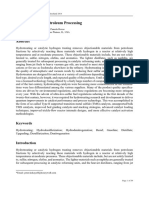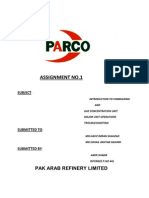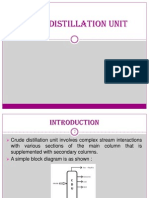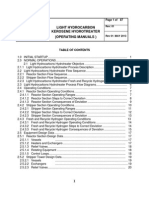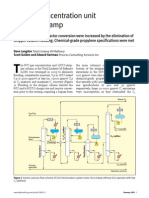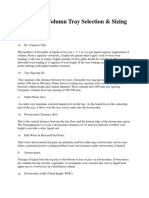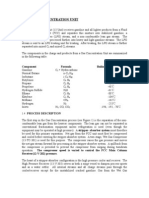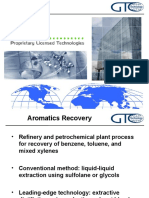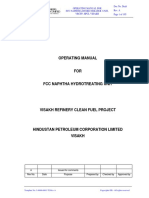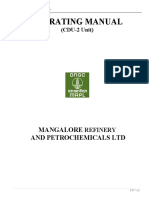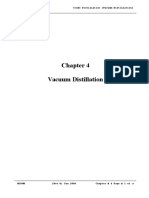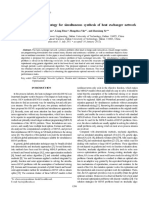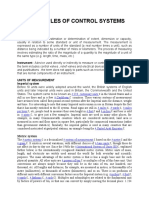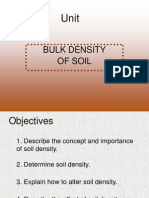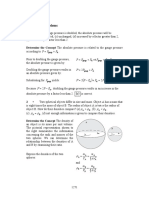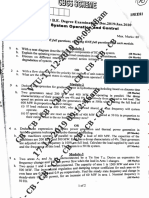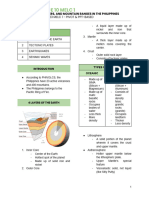C 5 Vacuum Distillation
C 5 Vacuum Distillation
Uploaded by
Ahmed Mohamed KhalilCopyright:
Available Formats
C 5 Vacuum Distillation
C 5 Vacuum Distillation
Uploaded by
Ahmed Mohamed KhalilOriginal Description:
Copyright
Available Formats
Share this document
Did you find this document useful?
Is this content inappropriate?
Copyright:
Available Formats
C 5 Vacuum Distillation
C 5 Vacuum Distillation
Uploaded by
Ahmed Mohamed KhalilCopyright:
Available Formats
Oil Refining Technology
Chapter 5 Vacuum Distillation
Chapter 5 Vacuum Distillation
OGS
(Rev.0) Feb. 2008
Page 1 of 20
Oil Refining Technology
Chapter 5 Vacuum Distillation
Chapter 5 Contents
5.1 Introduction 5.2 Reduced Crude Flashing
5.2.1 Vacuum Bottoms Handling 5.2.2 Entrainment Control 5.2.3 Product Condensation 5.2.4 Vacuum Pressure Measurement
5.3 Vacuum Fractionator 5.4 Steam Jet Ejectors
5.4.1 Introduction 5.4.2 Operating Principle 5.4.2.1 Steam Pressure 5.4.2.2 Discharge Pressure 5.4.2.3 Load 5.4.2.4 Cooling Water Temperature
5.5 Vacuum Tower Control System 5.6 Startup 5.7 Troubleshooting
OGS
(Rev.0) Feb. 2008
Page 2 of 20
Oil Refining Technology
Chapter 5 Vacuum Distillation
Chapter 5
Vacuum Distillation
5.1 INTRODUCTION
In order to maximize the production of gas oil and lighter components from the bottoms material of an atmospheric distillation unit, these bottoms (reduced crude) can be further distilled in a vacuum distillation unit. Vacuum distillation of an oil means that the pressure on the oil being distilled is lower than the atmospheric pressure. It does not mean that there is a perfect vacuum above the liquid. The distillation of heavy oils is conducted at a low pressure in order to avoid thermal decomposition or cracking at high temperature. A stock which boils at 400 C at 50 mm. would not boil until about 500 C at atmospheric pressure, at which temperature most hydrocarbons crack. For distillation to take place, the vapor pressure of the liquid being distilled must be a little greater than the pressure above it. The molecules that comprise a liquid are held together by two forcesnatural cohesion and the weight of the atmosphere pressing down. This pressure is equal to 14.7 psi. at sea level and will support a column of water 34 ft. high. Now if boiling will begin when the vapor pressure of the liquid has become a little greater than the pressure holding down, it is clear that by removing some of the holding down force the liquid will start boiling at a lower temperature. The vacuum unit differs from the atmospheric type in that it has a fractionating column of larger diameter with bubble trays farther apart. This is necessary because much larger volumes of vapors have to be handled because of the lower pressure. Any sudden increase in vacuum will expand the volume of the vapor rapidly and possibly result in puking the tower. In the vacuum unit, almost no attempt is made to fractionate the products. It is only desired to vaporize the gas oil, remove the entrained pitch, and condense the liquid product as efficiently as possible. Bottoms from the crude tower contain material that can be charged to the catalytic cracking unit or be used for lube oil stocks. Distilling this material at atmospheric pressure would require high temperatures that would cause thermal cracking. Thermal cracking is undesirable because it would cause a loss of valuable product, degradation of valuable product, and shortened run time due to coke formation in pipes and vessels. For these reasons we conduct the distillation of the heavy reduced crude under vacuum in the vacuum tower.
OGS
(Rev.0) Feb. 2008
Page 3 of 20
Oil Refining Technology
Chapter 5 Vacuum Distillation
To achieve a deep vacuum, pressure drop through the column must be kept low. Instead of the type trays weve discussed earlier, we use random packing and demister pads, to keep the vapor velocities low a large diameter tower is used. An actual operating vacuum tower is show in Figure 5.1. The side draws from the vacuum tower may be lube oil stocks or charge to the Cat. Cracker. The bottoms, vacuum residual, may be heavy fuel oil or asphalt.
OGS
(Rev.0) Feb. 2008
Page 4 of 20
Oil Refining Technology
Chapter 5 Vacuum Distillation
Figure 5.1 Vacuum Tower
Vertical Baffle
HIGH SULFUR RESID LOW SULFUR RESIB
OGS
(Rev.0) Feb. 2008
Page 5 of 20
Oil Refining Technology
Chapter 5 Vacuum Distillation
5.2 REDUCED CRUDE FLASHING
The reduced crude is charged through a heater into the vacuum column in the same manner as whole crude is charged to an atmospheric distillation unit. However, whereas the flash zone of an atmospheric column may be at 1-1.3 kg cm, the pressure in a vacuum column is very much lower. The vacuum heater transfer temperature is generally used for control, even though the pressure drop along the transfer line makes the temperature at that point somewhat meaningless. The flash zone temperature has much greater significance. The heater transfer and flash zone temperature are generally varied to meet the vacuum bottoms specification, which is probably either gravity or viscosity specification for fuel oil or a penetration specification for asphalt. The penetration of an asphalt is the depth in 1/100 cm, which a needle carrying a 100g weight sinks into a sample at 77F in 5 seconds, so that the lower the penetration the heavier the pitch. Very heavy pitches are called asphalts. If the flash zone temperature is too high the crude can start to crack and produce gases which overload the ejectors and break the vacuum. When this occurs, it is necessary to lower the temperature; and if a heavier bottoms product is still required, an attempt should be made to obtain a better vacuum instead. Slight cracking may occur without breaking the vacuum, and this is sometimes indicated by a positive result from the Oliensis Spot Test. The Oliensis Spot Test is a simple laboratory test which purports to indicate the presence of cracked components by the separation of these components when a 20% solution of asphalt in naphtha is dropped on a filter paper. Some crude always yield positive Oliensis asphalt, regardless of process conditions. If a negative Oliensis is demanded, operation at the highest vacuum and lowest temperature should be attempted. Since the degree of cracking depends on both the temperature and the time during which the oil is exposed to that temperature. The level of pitch in the bottom of the tower should be held at a minimum, and its temperature reduced by recalculating some pitch from the outlet of the pitch crude exchanger to the bottom of the column. It will often be observed that when the pitch level raises the column, vacuum falls because of cracking due to increased residence time. The flash zone temperature will vary widely depending upon the crude source pitch specifications, the quantity of product taken overhead, and the flash zone pressure and temperatures from below 315 to oven 425 C have been used in commercial operations.
OGS
(Rev.0) Feb. 2008
Page 6 of 20
Oil Refining Technology
Chapter 5 Vacuum Distillation
Some vacuum units are provided with facilities to strip the pitch with steam, and this will tend to lower the temperature necessary to meet an asphalt specification, but an excessive quantity of steam will overload the jets.
5.2.1 Vacuum Bottoms Handling
Pitch must be handled more carefully than most refinery products. The pitch pump which handle very hot, heavy material, have a tendency to lose suction. This problem can be minimized by recycling some cooled pitch to the column bottom and so reducing the tendency of vapor to form in the suction line. It is also important that the pitch pump glands be sealed in such a manner so as to prevent the entry of air. Since most pitches are sold at atmosphere temperatures, all pitch handling equipment must either be kept active, or flushed out with gas oil, when it is shut down. Steam tracing alone is sometimes inadequate to keep the pitch fluid, but where this is done, the highest pressure steam available should be used. Pitch is sometimes cooled in open box units, as shell and tube units are not efficient in this service. It is often desirable to send pitch to storage at high temperature to facilitate blending. If it is desired to increases the temperature of the pitch, it is better to do so by lowering the level of water in the open box, and not by lowering the water temperature. If the water in the box is too cold, pitch can solidify on the inside wall of the tube and insulate the hot pitch in the central core from the cooling water. Lowering the water temperature can actually result in a hotter product. When pitch is sent to storage at over 100 C, care should be taken to insure that the tank is absolutely free from water. Pitch coolers should always be flushed out with gas oil immediately once the pitch flow stops, since melting contents of a cooler is a slow job.
5.2.2 Entrainment Control
The vapor rising above the flash zone will entrain pitch, which cannot be tolerated in cranking unit charge. The vapor is generally washed with gas oil product, sprayed into the slop wax section. The mixture of gas oil and entrained pitch is known as slop wax, and it is often circulated over the decks to improve contact, though the circulation rate is not critical. The final stage of entrainment removal is obtained by passing the rising vapors through a metallic mesh demister blanket through which the fresh gas oil is sprayed.
OGS
(Rev.0) Feb. 2008
Page 7 of 20
Oil Refining Technology
Chapter 5 Vacuum Distillation
Most of the gas oil spray is revaporized by the hot rising vapors and returned up the column. Some slop wax must be yielded in order to reject the captured entrainment. The amount of spray to the demister blanket is generally varied so that the yield of slop wax necessary to maintain the level in the slop wax pan is about 5% of the charge. If the carbon residue or the metals content of the heavy vacuum gas oil is high, a greater percentage of slop wax must be withdrawn or circulated. Variation in the color of the gas oil product is a valuable indication of the effectiveness of entrainment control. Slop wax is a mixture of gas oil and pitch, and it can be recirculated through the heater to the flash zone and reflashed, if the plant has the capacity to do so. If, however, crude contains volatile material compounds, these will be recycled with the slop wax and can finally rise into the gas oil. Where volatile metals are a problem, it is necessary either to yield slop wax as a product, or to make lighter asphalt, which will contain the metal compounds returned with the slop wax.
5.2.3 Product Condensation
The scrubbed vapor rising above the demister blanket is the product, and no further fractionation is required. It is only desired to condense these vapors as efficiently as possibly. This could be done in a shell and tube condenser, but these are inefficient at low pressures, and the high pressure drop through such a condenser would raise the flash zone pressure. The most efficient method is to contact the hot vapors with liquid product which has been cooled by pumping through heat exchangers. It is further desired to usefully recover the heat of the rising vapors by heat exchange against crude oil, so we must arrange to have the circulating liquid at a high enough temperature to permit efficient heat exchange. We therefore have to compromise. If the gas oil circulation is high enough to condense all the vapors, the gas oil pan temperature will be so low that we will have inefficient heat exchange. In order to obtain a suitable high pan temperature we are forced to reduce the circulation rate until some of the vapors escape uncondensed. The problem of uncondensed vapors is easily solved by adding a small circulating LVGO section to catch these vapors by condensation against LVGO from a water cooler.
OGS
(Rev.0) Feb. 2008
Page 8 of 20
Oil Refining Technology
Chapter 5 Vacuum Distillation
The heavy vacuum gas oil circulation rate is chosen to maximize crude heat exchange. The best way of doing this on an operating unit is to observe the temperature of the crude leaving the crude / HVGO exchanger, then lower the HVGO circulation rate by 10%. If the crude temperature rises, the effect of the higher HVGO pan temperature has been greater than the effect reduced circulation, and we should try some more of the same % age. If the crude temperature is lower, we should try a 10 percent change in the opposite direction. Sometimes it is impossible to remove enough heat with crude exchange alone, and some HVGO from the outlet of the HVGO cooler is returned to the circulating line. This should only be done when necessary, since both heat and cooling water are wasted. The HVGO product is cooled and pumped to storage on HVGO pan level control. The LVGO section is a final contact condenser and normally the circulation rate should be adequate to keep the vapor to the jets within about 5C of cooling water temperature. A high circulation rate will provide a cushion against upsets.
5.2.4 Vacuum Pressure Measurement
Confusion often arises because of the different scales used to measure vacuum. Positive pressures are commonly measured as kilograms per square-centimeter gauge, which are kilograms per square centimeter above atmospheric pressure. Atmospheric pressure is 1.035 kg/cm2. Another means of measurement is to measure in millimeters of mercury. Atmospheric pressure (sea level) is 760 millimeters of mercury absolute while a perfect vacuum is 0 millimeters absolute. When vacuum are measured we can more conveniently do it by using millimeters of mercury absolute.
5.3 VACUUM FRACTIONATOR
The function of a vacuum tower (Figure 5.2) is to fractionate hydrocarbons that boil above approximately 700F (370C) in the crude tower. In the vacuum column, the pressure can be reduced to around 1.0 psia, below the slop wax tray. This is a total reduction in absolute pressure of perhaps 28.7 psi from the bottom of the crude tower. This large difference in pressure enables a great deal of hydrocarbon to flash overhead in the vacuum tower while maintaining a bottoms temperature not exceeding, for example, 730780F depending on the crude source. To further aid in removal of usable products from the bottoms material and to help produce proper penetration asphalt, stripping steam can be injected into the bottom boot of the column to decrease the partial pressure of the bottoms liquid. The bottom of the
OGS
(Rev.0) Feb. 2008
Page 9 of 20
Oil Refining Technology
Chapter 5 Vacuum Distillation
vacuum tower is swaged down to decrease the time that the bottoms liquid spends at the elevated bottoms temperature. A quench oil inlet line is also provided to protect the bottoms pumps. The feed line to a vacuum column is very large in comparison to the feed lines of most fractionators. This is because of the low pressure which causes almost all the vacuum column feed to be vapor. This also requires a special distributor called a tangential distributor that imparts a swirling direction to the feed and prevents damage to equipment above the distributor due to the rapid expansion of the feed as it enters the low pressure of the vacuum tower. The internals in the vacuum column are designed for a minimum amount of pressure drop, and the slop wax accumulator, the grid end demister pads are the only internals that extend completely across the entire column. The grid and demisters provide coalescing mediums to remove entrained liquid particles from the rapidly rising vapors. Spray distributors are used to aid the grid and demisters in coalescing. There are no trays in this vacuum tower, but what appear to be trays are side-by-side pans. Their outer edges perforated by holes and stiffened by metal lattice, the sideby-side pans overlap and provide a cascading effect to the condensed liquid. Hot vapors pass through the cascade to re-vaporize the lower boiling components of the liquid. Accumulator trays are designed to provide a vapor-free liquid to the suction of side draw pumps. Pump vents are returned to the column to allow removal of noncondensibles from the pump during startup. This helps a great deal in getting the pump started. After the pump is pumping properly, the vent should be closed. The top section of the vacuum column is swaged down because the traffic of material through the top of the column is much less than at the side draws. In fact, too many light ends in the feed or light ends formed by thermal decomposition of the bottoms would place an undue burden on the vacuum ejectors that have created and are maintaining the low pressure on the vacuum column. Vacuum columns are generally designed to withstand an internal pressure of 50 psi (3.5 Kg/cm2 gauge) and a 14.7 psia (760 mm absolute) external pressure. To strengthen the vessel walls to work between these two pressures, stiffeners are used. These are merely rings welded around the column and spaced a few feet apart.
OGS
(Rev.0) Feb. 2008
Page 10 of 20
Oil Refining Technology
Chapter 5 Vacuum Distillation
Figure 5.2 Vacuum Column
OGS
(Rev.0) Feb. 2008
Page 11 of 20
Oil Refining Technology
Chapter 5 Vacuum Distillation
The materials of construction used in the design of a vacuum tower are killed carbon steel for the vessel with the lower section clad with an 11-13% Cr. S.S. The slop wax accumulator is made of a 12% Cr. S.S. and the wall of the accumulator is lined with concrete. The grid is constructed of 304 stainless steel. The upper demister pad is constructed of Monel. Side-by-side pans are constructed of 12% Cr. S.S. The remainders are constructed of carbon steel. Designs for vacuum columns with different corrosion severities may allow the elimination of alloy cladding and some of the alloy in side-by-side pans and accumulators. Flash Towers Flash towers are used in services where good fractionation of the charge is not necessary. Their main purpose is to obtain the maximum amount of overhead product for a given transfer-line temperature. The feed material is heated to the desired temperature and the mixture of vapors and liquids is introduced into the flash space of a vessel. The liquid remaining after flashing falls to the bottom, usually through baffles to aid in separation and the vapors go overhead. Normally, an operation of this nature is used to remove asphalts and tar from crude before processing. Tar separators and tar stripper are the common names used for this type of tower.
5.4 STEAM JET EJECTOR
5.4.1 Introduction
Vacuum is maintained by two general methods vacuum pumps and jets. Vacuum jets are used extensively in yard equipment, whereas vacuum pumps are widely used in the laboratories. The vacuum system is used to remove vapors from the system which cannot be condensed. The common means for creating a vacuum in distillation is to use steam jet ejection. They can be employed singly or in stages to create a wide range of vacuum conditions. Their wide acceptance is based upon their having no moving parts and requiring very little maintenance. These vapors consist of non-condensible hydrocarbon vapors and air coming into the system with the feed and from leaks. Vacuum jets pull gases from the tower by using air, steam, or water in the jet. The jets generally use steam as the motivating material. A series of jets (normally three) is used to boost the gases from the
OGS (Rev.0) Feb. 2008 Page 12 of 20
Oil Refining Technology
Chapter 5 Vacuum Distillation
pressure of the vacuum tower to atmospheric pressure. The steam used to pull the gases and is condensed in each stage and removed as water. Figure 5.3 is a schematic diagram of a vacuum jet system. Water is removed from the jet stages by a pump or gravity flow from a water column. If the jets are 34 ft. above ground level the water flows out by gravity. At any height lower than 34 ft. the water must be pulled off with a pump.
Figure 5.3 Schematic Diagram of Vacuum Jet System Barometric systems are generally controlled by changing the water flow to the condenser for the first-stage jet. Control can be attained by varying steam to the jet. This type of control is normally not as effective as varying the condenser water. Every vacuum system has a definite capacity. This capacity is measured as to the quantity of non-condensable removed at a definite vacuum. As the quantity of non-condensable exceeds the capacity of the jets, the vacuum begins to fail off. Therefore as the cooling water to the first stage jets is reduced the quantity of non-condensed gases exceeds the capacity of the jet and causes the vacuum to fail off.
5.4.2 Operating Principle
Figure 5.4 illustrates a typical two-stage ejector system. In an ejector the steam is injected at high velocity through a specially designed nozzle (Figure 5.5) and transfers sufficient energy to the gases from the suction header to entrain them through the diffuser into the first-stage discharge header. The pressure in the first-
OGS
(Rev.0) Feb. 2008
Page 13 of 20
Oil Refining Technology
Chapter 5 Vacuum Distillation
stage discharge header is, of course, higher than the pressure in the suction header, but if the velocity of the steam through the diffuser throat is high enough, gas cannot back into the suction header. If a single ejector is incapable of raising the gases to atmospheric pressure at which they can be vented, the steam is condensed and a second ejector taking suction of the non-condensable gases raises them to a higher pressure. The dimensions of an ejector are quite critical so that any given ejector will only operate ever a relatively limited range. A substantial change in suction or discharge conditions will probably demand a change in the dimensions of the nozzle or diffuser, or both. The effect of changes in operating conditions can be summarized as follows: 5.4.2.1 Steam Pressure Must be maintained quite close to that for which the equipment was designed. If the steam pressure greatly exceeds that for which the nozzle was designed, the quantity of steam discharging into the diffuser will be greater than can pass through the diffuser, and steam will back into the suction header. Too low a steam pressure will mean a drastic loss in performance of the ejector. It should be noted that wet steam will cause random fluctuations in ejector performance and in addition will erode the nozzle and diffuser. 5.4.2.2 Discharge Pressure If the discharge pressure rises above design, there is an increasing probability of reverse flow. An increase in discharge pressure on an ejector discharging to atmosphere is only possible if the discharge is obstructed. But on multi-stage units an increase in interstage pressure due to high condensate temperatures or failure of a second or third-stage ejector will immediately affect the performance of the firststage unit. 5.4.2.3 Load A decrease in load (kg/hour of vapor to ejector) will result in a somewhat higher vacuum being obtained, but if the load is increased above design, the vacuum obtained will fall off quite suddenly and dramatically.
OGS
(Rev.0) Feb. 2008
Page 14 of 20
Oil Refining Technology
Chapter 5 Vacuum Distillation
Figure 5.4 Typical Arrangement Vacuum Unit 2-Stage Jets
OGS
(Rev.0) Feb. 2008
Page 15 of 20
Oil Refining Technology
Chapter 5 Vacuum Distillation
Figure 5.5 Cut-Away View of Steam Jet Ejector
OGS
(Rev.0) Feb. 2008
Page 16 of 20
Oil Refining Technology
Chapter 5 Vacuum Distillation
5.4.2.4 Cooling Water Temperature The temperature at which the steam is condensed in the inter and final condensers will have a relatively minor effect on the vacuum obtained, but will substantially reduce the load at which the ejector system breaks down, since an increase in condensate temperature increases the inter-stage pressure. In order to insure flexibility a refinery ejector system for a vacuum unit will generally be constructed using two parallel sets. The minimum combination of equipment which will achieve a satisfactory vacuum is normally used. The vapors drawn from the top of a typical vacuum unit to the jets consists of air from leaks, steam entrained from the bottom of the crude distillation tower, light hydrocarbons, and sulfur and nitrogen compounds from thermal decomposition in the heater, and any hydrocarbons lighter than gasoline which have not been stripped from the charge. The steam and light hydrocarbons will condense in the inter-condenser so that the first-stage ejectors can be heavily loaded under conditions which only lightly load the second-stage ejectors. Any actual cracking in the furnace will produce light gases which will very rapidly overload the second-stage ejectors. Both the condensable and non-condensable vapors handled by a typical vacuum unit ejector set are highly odiferous so that the condensate must be stripped and the noncondensable vapors incinerated.
5.5 VACUUM TOWER CONTROL SYSTEM
Steam pressure below a critical value of a jet will cause the ejector operation to be unstable. Therefore, it is recommended to install a pressure controller on the steam to keep it at the optimum pressure required by the ejector. The recommended control system for vacuum distillation is shown in Figure 5.5. Air or gas is bled into the vacuum line just a head of the ejector. This makes the maximum capacity of the ejector available to handle any surges or upsets. A pressure control valve regulates the amount of bleed air used to maintain the pressure on the reflux Drum. The liquid overhead product shall always be sub-cooled to avoid excessive loss of product vapor to the evacuating equipment.
OGS
(Rev.0) Feb. 2008
Page 17 of 20
Oil Refining Technology
Chapter 5 Vacuum Distillation
Figure 5.6 Vacuum Column Pressure Control
5.6 STARTUP
When starting a vacuum unit it is common practice to steam out the heater and tower and then pressure test the tower with steam at about 50 psig. It will be assumed that this has been done and that all valves around the ejectors are closed. a. Shut off steam to the tower. b. Vent steam from top of tower until the pressure is about 0.2 Kg/cm2, then close end plug the top vent. c. Open the inlet and outlet valves of one of the second-stage ejectors. d. Open the inlet and outlet valves of one of the first-stage ejectors. e. Open water through both condensers. f. Open steam to both first and second-stage ejectors. g. Check that the steam is dry and adjust the steam pressure to that given on the equipment name plate. As soon as a level appears in the inter-condenser, start the condensate pump and place the level on control.
OGS
(Rev.0) Feb. 2008
Page 18 of 20
Oil Refining Technology
Chapter 5 Vacuum Distillation
h. Let the ejectors run until a constant vacuum is obtained even though the presence of water in the tower may result in a poor initial vacuum. i. Charge the vacuum unit and proceed with normal operations. Adding Additional Ejectors The operators should observe and get to know the interstage pressure which gives the most stable operation on a given ejector set. On most two-stage units, this is about 260-130 mm Hg. absolute vacuum. When the tower vacuum either decreases or becomes sensitive to process conditions, additional ejector capacity should be added. If the interstage pressure has risen (the vacuum as measured in mm Hg. has increased), an additional second-stage jet should be added. If the interstage pressure is unchanged, but the lower pressure has risen, an additional first-stage jet should be added and this may render the addition of another second-stage jet necessary. a. Open the ejector discharge valve. b. Open the steam to the nozzle. c. Check that the nozzle steam pressure is under good control. d. Open the ejector suction valve.
5.7 Troubleshooting
Occasionally, ejectors will fail to pull an adequate vacuum or will perform erratically. This can be the result of a large number of troubles, a few of which are listed below for checking. a. Air leaking Into the System: Hot bolt all flanges and manways on the vacuum tower and on the overhead line. Tighten and oil all valve packing glands. Plug all vents and drain valves and tighten any screwed connection. Check that pump gland flushing is adjusted to maintain a positive pressure on the gland. b. Air Leaking Into Interstage: This will be confirmed by a rise in interstage pressure. Tighten all flanges, pump glands and screwed connections. Check that the condensate drain trap is not stuck and bleeding air back from the second stage.
OGS
(Rev.0) Feb. 2008
Page 19 of 20
Oil Refining Technology
Chapter 5 Vacuum Distillation
c. Leaking Behind Nozzle: Certain styles of ejectors can readily leak air or steam through a leak in the point where the nozzle is attached to the body. d. Wrong Steam Pressure: Check ejector name plate data and change pressure controller setting. e. Wet Steam: Causes erratic performance. Check performance of steam traps. f. Worn Nozzles and Diffusers: The result of using wet steam. g. Clogged Steam Filters: There is generally a main filter ahead of the steam pressure controller and a filter in the nozzle of each ejector. h. High Condensate Temperatures: The result of insufficient cooling water flow or fouling of either the tube or the shell side of the condensers. i. Flooded Condensers: The result of malfunctions of the level controller or the condensate drain trap, or of pump failure. If the pump will not hold suction, check that air is not leaking in at the gland. l. Faulty Installation: Failure to properly align gaskets and similar details which are normally insignificant can trap condensate pockets or cause turbulence which can affect the performance of vacuum equipment. If an ejector set has been dismantled, each nozzle must of course be reinstalled in the correct diffuser. j. Back Pressure: Due to deposits in the condensers, a plugged flame arrester in the vent, a condensate pocket or other obstruction. k. Impossible Operation: Such as attempting to obtain an absolute pressure lower than the vapor pressure of a liquid in the system. If a very little vacuum gas oil is produced it may be so light that it will be impossible to pull a vacuum on the tower. m. High-Tower Bottom Level: If the level in the tower is permitted to rise, some cracking will occur because the pitch is being held at a high temperature for too long. n. Steam Entering System: Check steam-out connections on the tower, heater, exchangers, etc. o. Cracking in Furnace: Experienced at very high transfer temperatures and can be checked by running an Oliensis on the pitch, or a bromine number on the light vacuum gas oil. Where a leak is elusive, a special meter can be installed to measure the noncondensable being vented and these vent gases can be analyzed in the laboratory.
OGS (Rev.0) Feb. 2008 Page 20 of 20
You might also like
- 18 - Fire Development and Syndicate Exercise PPT For LearnerDocument23 pages18 - Fire Development and Syndicate Exercise PPT For LearnerSophie-Louise MercedesNo ratings yet
- 1.1 Atomic Structure EXAMPRODocument36 pages1.1 Atomic Structure EXAMPROamandasparkle100% (1)
- Hydrotreating - UOP - A Honeywell CompanyDocument59 pagesHydrotreating - UOP - A Honeywell CompanySamNo ratings yet
- Uop Parex Process: Scott E. CommissarisDocument8 pagesUop Parex Process: Scott E. CommissarisBharavi K SNo ratings yet
- Merox SweeteningDocument15 pagesMerox Sweeteningajay7892No ratings yet
- Uop Par-Isom Process: Nelson A. CusherDocument6 pagesUop Par-Isom Process: Nelson A. CusherBharavi K S100% (1)
- PROII User-Added Subroutines User GuideDocument536 pagesPROII User-Added Subroutines User Guidedquigley100% (1)
- Vacuum Distillation (Ok)Document112 pagesVacuum Distillation (Ok)Ahmed Mohamed Khalil100% (2)
- Vacuum Distillation UnitDocument15 pagesVacuum Distillation Unitshaz100% (2)
- Basra Light - Summary Crude Oil Assay ReportDocument3 pagesBasra Light - Summary Crude Oil Assay ReportAhmed Mohamed KhalilNo ratings yet
- C CC CC: CCCCCCCCCCCCCCCCDocument27 pagesC CC CC: CCCCCCCCCCCCCCCCMuhammadTanzeeLUsmanNo ratings yet
- UOP MeroxfixedbedDocument2 pagesUOP Meroxfixedbednebulakers100% (1)
- Vacuum Residue PDFDocument17 pagesVacuum Residue PDFMarcos MaldonadoNo ratings yet
- Hadnling Assays in PROIIDocument50 pagesHadnling Assays in PROIIHernan RodriguezNo ratings yet
- Dehydration of Ethanol To EthyleneDocument10 pagesDehydration of Ethanol To EthylenewiboonwiNo ratings yet
- Optimize Sour Water Stripper Feed Preheating For Low Capital PDFDocument6 pagesOptimize Sour Water Stripper Feed Preheating For Low Capital PDFDaniel Gonzalez RodriguezNo ratings yet
- Design Slides FinalDocument231 pagesDesign Slides FinalPrem Sagar100% (1)
- UOP PROCESS DES 10.6 Aromatics, Online Italian Encyclopedia of Hydrocarbons, Volume II, 2006, Pages 603-605.591-614 - ING3Document48 pagesUOP PROCESS DES 10.6 Aromatics, Online Italian Encyclopedia of Hydrocarbons, Volume II, 2006, Pages 603-605.591-614 - ING3timNo ratings yet
- Vassili Ribkin-En PDFDocument22 pagesVassili Ribkin-En PDFKosan NamnamNo ratings yet
- OPERATING MANUALS - Kerosene Hydrotreater Rev 01 - 3Document13 pagesOPERATING MANUALS - Kerosene Hydrotreater Rev 01 - 3MohamadMostafavi100% (2)
- De Ethanizer ColumnDocument24 pagesDe Ethanizer Columnrohit agrawalNo ratings yet
- Design of Valve TrayDocument4 pagesDesign of Valve TrayVirendra BhagatNo ratings yet
- Characterization and Prediction of Water Droplet Size in Oil Water Flow - J Yao - MSDocument183 pagesCharacterization and Prediction of Water Droplet Size in Oil Water Flow - J Yao - MSGianmarco Corticelli100% (1)
- Merox & HydrotreatmentDocument18 pagesMerox & HydrotreatmentLuis Acid100% (2)
- Delayed Coker Fired Heater Designand Operation Fouling PDFDocument10 pagesDelayed Coker Fired Heater Designand Operation Fouling PDFMajid MohebbifarNo ratings yet
- Design of Caustic Wash System For Light HydrocarboDocument5 pagesDesign of Caustic Wash System For Light HydrocarboWayne MonneryNo ratings yet
- FCC GCU Stripper RevampDocument5 pagesFCC GCU Stripper RevampRavi NookalaNo ratings yet
- Leading Tray TechnologyDocument24 pagesLeading Tray Technologyachmad.No ratings yet
- Catalyst Passivation For Safer, More Efficient TurnaroundsDocument4 pagesCatalyst Passivation For Safer, More Efficient TurnaroundsAltif AboodNo ratings yet
- 3DG-B32-00004 Crude & Vacuum UnitsDocument32 pages3DG-B32-00004 Crude & Vacuum UnitsCarlos0% (1)
- Design Concept of Crude Oil Distillation Column DesignDocument24 pagesDesign Concept of Crude Oil Distillation Column DesignArjumand UroojNo ratings yet
- Optimising Preflash For Light Tight Oil ProcessingDocument8 pagesOptimising Preflash For Light Tight Oil Processingmathew8No ratings yet
- Distillation Calculation FormulasDocument21 pagesDistillation Calculation FormulasVaibhav Mishra100% (2)
- Gas ConDocument19 pagesGas ConDeepesh AggarwalNo ratings yet
- Distillation Column - Column Internals, Bubble Cap Trays, Valve Trays, Sieve Trays, Structured PackingDocument10 pagesDistillation Column - Column Internals, Bubble Cap Trays, Valve Trays, Sieve Trays, Structured PackingdileepNo ratings yet
- 16 Options For Gasoline Pool Benzene ManagementDocument14 pages16 Options For Gasoline Pool Benzene Managementxinghust100% (1)
- Sour Water Treatment UnitDocument16 pagesSour Water Treatment Unitpkgarg_iitkgp100% (2)
- Evaluation of Propane Deasphalting Extractor by Replacing Regular Packing Instead of TraditionalDocument60 pagesEvaluation of Propane Deasphalting Extractor by Replacing Regular Packing Instead of Traditionalfarah al-sudaniNo ratings yet
- GTCDocument80 pagesGTCmehul10941No ratings yet
- Choosing Column InternalsDocument7 pagesChoosing Column Internalspetrolhead1No ratings yet
- NHTDocument6 pagesNHTPadarthi Venkateswarlu50% (2)
- DesulphurizationDocument43 pagesDesulphurizationNithinKallayilNo ratings yet
- UOP Controlling FCC Yields and EmissionsDocument30 pagesUOP Controlling FCC Yields and Emissionssaleh4060No ratings yet
- Generic CDU and VDUDocument187 pagesGeneric CDU and VDUHassanSalem100% (2)
- FCCNHT ManualDocument195 pagesFCCNHT Manualsathya perumalNo ratings yet
- Basics of Hydrotreating Catalyst Sulfiding - Reactor Resources - Sulfiding Services, Alumina, Metal Reclamation, CatalystsDocument5 pagesBasics of Hydrotreating Catalyst Sulfiding - Reactor Resources - Sulfiding Services, Alumina, Metal Reclamation, Catalystsonizuka-t2263No ratings yet
- Divided Wall Column 496Document6 pagesDivided Wall Column 496GeorgeNo ratings yet
- CDU-2 Operating Manual For UpdationDocument192 pagesCDU-2 Operating Manual For UpdationSagar KumarNo ratings yet
- 09 NaturalGasDehydrationWithTEGDocument20 pages09 NaturalGasDehydrationWithTEGGustavo ValleNo ratings yet
- Fluid Catalytic CrackingDocument16 pagesFluid Catalytic Crackingbubalazi100% (1)
- 10a-Field Evaluation of Heaters ModDocument24 pages10a-Field Evaluation of Heaters ModTissa1969No ratings yet
- Pre-Reformer Catalyst in A Hydrogen PlantDocument4 pagesPre-Reformer Catalyst in A Hydrogen Plantbikas_saha100% (1)
- Quench Towers Published PaperDocument6 pagesQuench Towers Published PaperSrinivasan RajenderanNo ratings yet
- 4269chapter 4 Crude DistillationDocument19 pages4269chapter 4 Crude DistillationJuan Carlos Barrera Quijano100% (1)
- 11-Troubleshooting Oil FiringDocument19 pages11-Troubleshooting Oil FiringLuis Enrique Leyva OvalleNo ratings yet
- Oil Ref Walk ThroughDocument7 pagesOil Ref Walk ThroughSumedh SinghNo ratings yet
- Petronas Technical Standards: Filters For Removing Particles From Hydroprocesser Feeds - Type Selection and Design RulesDocument46 pagesPetronas Technical Standards: Filters For Removing Particles From Hydroprocesser Feeds - Type Selection and Design Rulesahmadreza777No ratings yet
- Distillation DesignDocument30 pagesDistillation DesignAPURVA SUMAN 18CH10033100% (1)
- 8 HydrotreatingDocument31 pages8 HydrotreatingAmroKasht100% (3)
- Selection of Internals For Distillation ColumnsDocument29 pagesSelection of Internals For Distillation ColumnsAliya JamesNo ratings yet
- Multiphase Catalytic Reactors: Theory, Design, Manufacturing, and ApplicationsFrom EverandMultiphase Catalytic Reactors: Theory, Design, Manufacturing, and ApplicationsNo ratings yet
- Vaccum DistillationDocument36 pagesVaccum Distillationquangquy91No ratings yet
- Crude Distillation PosterDocument1 pageCrude Distillation Postervivek_rec100% (1)
- Optimal Process Design With Model Parameter Uncertainty and Process VariabilityDocument12 pagesOptimal Process Design With Model Parameter Uncertainty and Process VariabilityAhmed Mohamed KhalilNo ratings yet
- Arabian HeavyDocument2 pagesArabian HeavyAhmed Mohamed KhalilNo ratings yet
- Basra16Y: Exxonmobil Refining and Supply CompanyDocument4 pagesBasra16Y: Exxonmobil Refining and Supply CompanyAhmed Mohamed Khalil100% (1)
- A Hybrid Optimization Strategy For Simultaneous Synthesis of Heat Exchanger NetworkDocument12 pagesA Hybrid Optimization Strategy For Simultaneous Synthesis of Heat Exchanger NetworkAhmed Mohamed KhalilNo ratings yet
- Huang2012, Heat Exchanger Network Synthesis Using A Hyperstructure of Stagewise Stream SuperstructuresDocument5 pagesHuang2012, Heat Exchanger Network Synthesis Using A Hyperstructure of Stagewise Stream SuperstructuresAhmed Mohamed KhalilNo ratings yet
- Heat Exchanger Network Design Using Pinch Analysis PDFDocument25 pagesHeat Exchanger Network Design Using Pinch Analysis PDFAhmed Mohamed Khalil100% (1)
- Transshipment LP Model For Minimizing PDFDocument7 pagesTransshipment LP Model For Minimizing PDFAhmed Mohamed KhalilNo ratings yet
- Heat Exchanger Network Design Using Pinch Analysis PDFDocument25 pagesHeat Exchanger Network Design Using Pinch Analysis PDFAhmed Mohamed Khalil100% (1)
- CH 1.2 ISA Symbols: Module ObjectivesDocument6 pagesCH 1.2 ISA Symbols: Module ObjectivesAhmed Mohamed KhalilNo ratings yet
- 3 Papoulias, Grossmann (1983) - A Structural Optimization Approach in Process Synthesis II. Heat Recovery NetworksDocument15 pages3 Papoulias, Grossmann (1983) - A Structural Optimization Approach in Process Synthesis II. Heat Recovery NetworksAhmed Mohamed KhalilNo ratings yet
- Nptel Chemical Engineering Petroleum Refinery Engineering9Document6 pagesNptel Chemical Engineering Petroleum Refinery Engineering9Ahmed Mohamed KhalilNo ratings yet
- 1.principles of Control SystemsDocument42 pages1.principles of Control SystemsAhmed Mohamed KhalilNo ratings yet
- 09 - Jan Steegstra - Chevron Lummus GlobalDocument24 pages09 - Jan Steegstra - Chevron Lummus GlobalAhmed Mohamed KhalilNo ratings yet
- Sulfur Recovery: Based On Presentation by Prof. Art KidnayDocument36 pagesSulfur Recovery: Based On Presentation by Prof. Art KidnayAhmed Mohamed KhalilNo ratings yet
- What Is Steam?: Triple PointDocument9 pagesWhat Is Steam?: Triple PointAhmed Mohamed KhalilNo ratings yet
- Application of Geophysical Technique in The Coal Mining: Yue LeiDocument3 pagesApplication of Geophysical Technique in The Coal Mining: Yue LeiwypoNo ratings yet
- HVAC Layout For The Condo UniDocument1 pageHVAC Layout For The Condo UniBambi San GabrielNo ratings yet
- Sustainable PoetryDocument333 pagesSustainable PoetryGuillermo Guadarrama MendozaNo ratings yet
- Semester - 3: Chemical EngineeringDocument135 pagesSemester - 3: Chemical EngineeringKevinNo ratings yet
- Soil Erosion 5Document39 pagesSoil Erosion 5Chester TimothyNo ratings yet
- Psaab1 6 Bulk Density of SoilDocument21 pagesPsaab1 6 Bulk Density of SoilNiiteSajoNo ratings yet
- Sistemas de Corriente AlternaDocument2 pagesSistemas de Corriente AlternaErick Eduardo Barrantes QuirosNo ratings yet
- Cetd Unit 4Document37 pagesCetd Unit 4Laxmi PrasannaNo ratings yet
- Chapter - 5 - The Ailing Planet - The Green Movement's Role (Hornbill)Document17 pagesChapter - 5 - The Ailing Planet - The Green Movement's Role (Hornbill)Neha ArmyNo ratings yet
- Heat With Phase Change Extra WSDocument5 pagesHeat With Phase Change Extra WSivanaNo ratings yet
- Eco LiteracyDocument42 pagesEco LiteracyJohlian TajanlangitNo ratings yet
- Renewable and Non Renewable SourcesDocument33 pagesRenewable and Non Renewable SourcesSneha DeshmukhNo ratings yet
- Chapter 13 Fluids Conceptual Problems PDFDocument76 pagesChapter 13 Fluids Conceptual Problems PDFTransAm FajariansyahNo ratings yet
- 16eemme023 Seminar ReportDocument9 pages16eemme023 Seminar ReportShreya RathoreNo ratings yet
- Conditional SentencesDocument5 pagesConditional SentencesLan AnhNo ratings yet
- Psoc QPDocument8 pagesPsoc QPSandesh KulalNo ratings yet
- Analysis of Electricity Generation With Combined Power Systems For Residential BuildingsDocument21 pagesAnalysis of Electricity Generation With Combined Power Systems For Residential Buildingsboforo3821No ratings yet
- Iprint NiiiiiiiiiDocument32 pagesIprint NiiiiiiiiiLyca Mae PogoyNo ratings yet
- Thailand Solar Tracker System (Eng1)Document23 pagesThailand Solar Tracker System (Eng1)Hafiezul HassanNo ratings yet
- Meteorology (Met) : (Subra, Page 62, Example 4)Document4 pagesMeteorology (Met) : (Subra, Page 62, Example 4)red gadgetbdjNo ratings yet
- Atwood ExperimentDocument3 pagesAtwood ExperimentDenil BinuNo ratings yet
- Acid RainDocument8 pagesAcid RainTimur EvstafievNo ratings yet
- Ap11 FRQ BiologyDocument3 pagesAp11 FRQ BiologyAnkit BhandaryNo ratings yet
- SCIENCE 10 MELC 1 - Volcanoes, Epicenters, and Mountain Ranges in The PHDocument3 pagesSCIENCE 10 MELC 1 - Volcanoes, Epicenters, and Mountain Ranges in The PHXamantha Jean Brianne MedinaNo ratings yet
- NEET Biology Chapter Wise Mock Test - Biodiversity and Wildlife Conservation - CBSE TutsDocument27 pagesNEET Biology Chapter Wise Mock Test - Biodiversity and Wildlife Conservation - CBSE Tutssreenandhan 2017No ratings yet
- Velocity Boundary LayerDocument3 pagesVelocity Boundary LayerThe UltimateNo ratings yet
- Podani: Taxonomy in Evolutionary Perspective (Synbiol. Hung. 6:1-42, 2010)Document42 pagesPodani: Taxonomy in Evolutionary Perspective (Synbiol. Hung. 6:1-42, 2010)podaniNo ratings yet
- Chemical Thermodynamics: Amper, Jan Christian Di Mdi Man, Pat R Ick Jun E Ry Sievert, ReinalynDocument18 pagesChemical Thermodynamics: Amper, Jan Christian Di Mdi Man, Pat R Ick Jun E Ry Sievert, ReinalynKyla CanlasNo ratings yet


